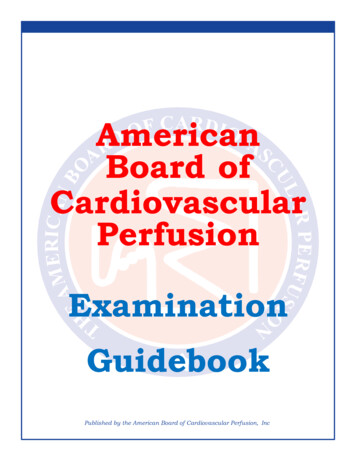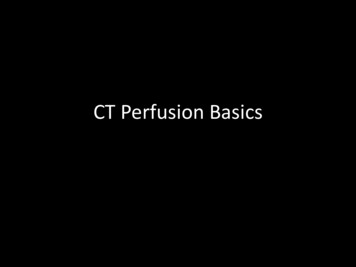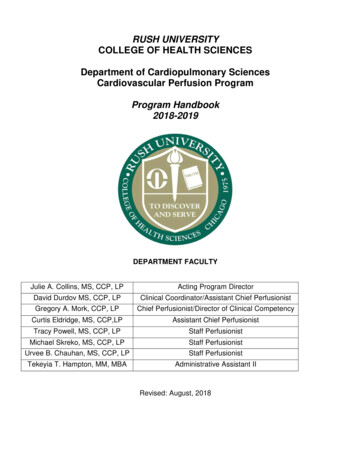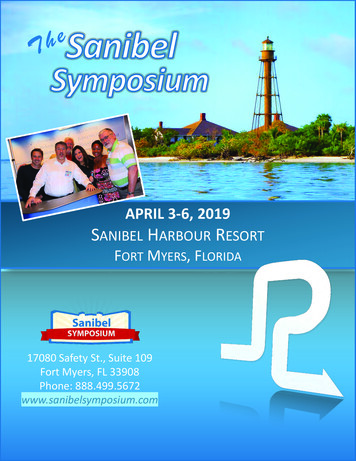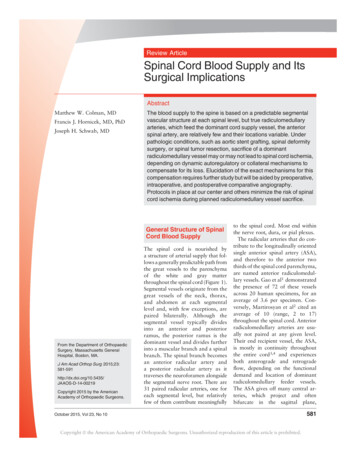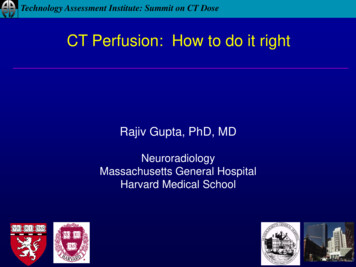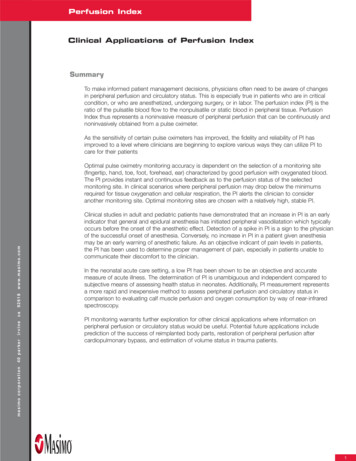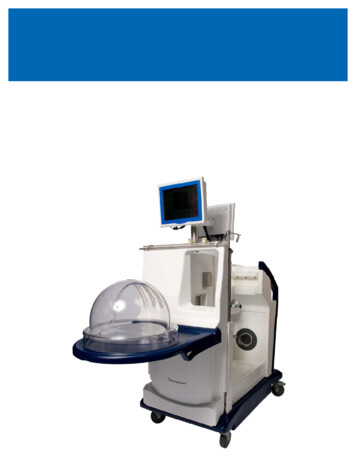
Transcription
XVIVO PERFUSION SYSTEM (XPSTM)Professional Instructions for UseXVIVO Perfusion System (XPSTM) Instructions for Use‐130‐Revision G
Copyright 2010, 2011, 2012, 2013,2014XVIVO Perfusion AB, all rights reservedSubject to technical changesBecause of continuous productimprovements, the illustrations andtechnical information found in the XPSUser’s Guide may differ (slightly) from thecurrent version of the device.User Guide ReferencesThis document was created using information from:1) CardioHelp User’s Manual/English/0.9.02) CardioHelp XVIVO/TechnicalData/Maintenance/ English/1008133) Flow/bubble sensor/ Technical Data/English/1008124) Hamilton C2 Operator’s Manual624131/02 Software version 1.1.x (April2009)5) Hico‐Variotherm 550 Instructions forUse/ REF 542801 Rev.2‐08/05Manufacturer:XVIVO Perfusion AB Box53015SE‐400 14 GöteborgSwedenVisitors/deliveries:Mässans gata 10 SE‐412 51Göteborg SwedenTelephone: 46 31 788 21 50Distributed in the US by:XVIVO, Inc.3666 S Inca St. Englewood, CO80110Telephone: (303) 395‐9171 www.xvivoperfusion.comXVIVO Perfusion System (XPSTM) Instructions for Use‐130‐Revision G
XVIVO Perfusion System (XPSTM) with Steen Solution TMProfessional LabelingCAUTIONHumanitarian Device. Authorized by Federal law for use in flushing and temporary continuous normothermicmachine perfusion of initially unacceptable excised donor lungs during which time the ex-vivo function of the lungscan be reassessed for transplantation. The effectiveness of this device for this use has not been demonstrated.XVIVO Perfusion Clinical & Technical SupportPhone NumbersUS Clinical SupportU.S. Technical SupportU.S. Main Switchboard303-395-9171READ ENTIRE CONTENTS PRIOR TO USING THIS PRODUCTProduct Indication for UseThe XVIVO Perfusion System (XPS ) with STEEN Solution Perfusate is indicated for the flushing and temporarycontinuous normothermic machine perfusion of initially unacceptable excised donor lungs during which time the exvivo function of the lungs can be reassessed for transplantation.User QualificationsThis product is intended for use only by qualified medical professionals trained in the particular technique and/orsurgical procedure to be performed.Rx ONLY - PRESCRIPTION USE ONLYCaution: Federal law restricts this device to sale by or on the order of a physician.CONTRADICATIONSThere are no known contraindications.WARNINGSGeneral WarningsThe safety and probable benefit of the XPS System with STEEN Solution Perfusate device were not evaluatedwith ideal criteria donor lungs.Risk for contamination and mechanical trauma:The degree of organ manipulation required for airway and vascular cannulation carries the potential forcontamination and mechanical trauma of the donor lungs. Even though not contraindicated, it is not recommendedto use an organ with evident signs of mechanical trauma or major contamination.Transplant Suitability Post-Ex Vivo Lung Perfusion (EVLP)The responsibility for correct clinical use and interpretation of the lung function evaluations during EVLP indetermining transplant suitability resides exclusively with the transplant surgeon.Like in any other clinical decision, all available data should be taken into consideration when determining thesuitability of an organ for transplantation; that is, the transplant surgeon is clinically satisfied with the lungevaluation. This criterion should take priority, since the transplant surgeon is the ultimate responsible person forsafely transplanting EVLP lungs. The use of the EVLP lung physiologic evaluations in determining transplantability(e.g., EVLP transplantability criteria) has been evaluated in the clinical studies, including the NOVEL trial (seeXVIVO Perfusion System (XPSTM) Instructions for Use‐130‐Revision G
summary of NOVEL study below). Validation has not occurred as to whether the parameters are adequate assurrogates for in vivo performance.XPS Machine operation-related WARNINGSSee Warnings and Precautions in the XPS System Instructions for Use manual.STEEN Solution The responsibility for correct clinical use and technique rests with the user. The Instructions for Use are onlyprovided as suggestions for procedure. The user must, on the basis of his or her medical training and experience,evaluate the suitability of this procedure.Adverse Effects – When administered systemically, human serum albumin and Dextran have been associated withrare allergic reactions However, no such reactions have been reported with either of these substances when usedfor ex vivo lung preservation.PRECAUTIONSXVIVO Cannula setStore at room temperature. Use only undamaged/ unopened containers. Single Use Only.XVIVOTM Organ ChamberStore at room temperature. Use only undamaged/ unopened containers. Single Use Only.XPSTM Lung CircuitStore at room temperature. Use only undamaged/ unopened containers. Single Use Only.XVIVO Lung Disposables KitStore at room temperature. Use only undamaged/ unopened containers.XPS Machine operation-related PRECAUTIONSSee Warnings and Precautions in the XPS System Instructions for Use manual.STEEN Solution STEEN Solution is intended for single use only and MAY NOT BE REUSED. Any leftover solution must bedisposed of after the procedure.Do not use STEEN Solution if the solution is not clear, the bottle is damaged, the flip-tear seal has beentampered with, or if the “use by” date has expired.DESCRIPTIONThe XPS with STEEN Solution Perfusate consists of the XPS Perfusion Cart Hardware, fluid path and non-fluidpath disposables, XPS Cart Software, and STEEN Solution .The STEEN Solution is a clear, sterile, non-pyrogenic, non-toxic, physiological, extracellular (low potassium)electrolyte solution containing human serum albumin (HSA) and dextran 40. The solution has a colloid-osmoticpressure (COP) so that during perfusion a physiological pressure and flow can be maintained in the lung without thedevelopment of pulmonary edema (fluid accumulation in the air spaces and parenchyma of the lungs).The XPS System is an integrated cardiac bypass system comprised of various components, such as a MaquetCardioHelp centrifugal pump (K102726), the HicoVariotherm Heater/Cooler, the Hamilton C2 ICU (intensive careunit) pressure-controlled ventilator (K092148), the perfusate gas monitors, and the display monitors.The XPS System is responsible for housing the organ for preservation, providing the normothermic environment,and perfusing the organ with the STEEN Solution . Please see the XPS Instructions for Use manual for a moredetailed device description and system set-up and operation information, including flow and perfusion rates,ventilation rates, duration of flushing, and other operational parameters.XVIVO Perfusion System (XPSTM) Instructions for Use‐130‐Revision G
STEEN Solution The STEEN Solution is supplied sterile in a bottle made of PETg and equipped with a PE screw cap lined with asilicone septum closure, which facilitates aseptic transfer of the solution. The screw cap is sealed by a temperevident plastic sleeve. The STEEN Solution product insert should be read prior to use of this product.XPS MachineThe XVIVO Perfusion Cart will be shipped in a large wooden crate container.XVIVO Cannula set The XVIVO Lung Cannula Set is a sterile, single-use Set intended to be used to connect isolated donor lungs toan extracorporeal perfusion system for ex-vivo assessmentXVIVO Organ Chamber The XVIVO Organ Chamber is a sterile, single-use container intended to be used as a temporary receptacle forisolated donor lungs in preparation for eventual transplantation into a recipient.XPSTM Lung CircuitTMThe XPS Lung Circuit is a single-use, disposable extracorporeal perfusion circuit intended to be used with theTMTMXVIVO Perfusion System (XPS ) to facilitate perfusion of STEEN Solution through isolated donor lungs inpreparation for eventual transplantation into a recipient.XVIVO Lung Disposables KitThe XVIVO Lung Disposables Kit contains a number of single-use, disposable sterile and non-sterile items intendedTMto be used with the XVIVO Perfusion System (XPS ) for ex-vivo evaluation of donor lungs.The XVIVO Lung Disposable Kit contains the following items: Fluid Level Sensor, Pressure Sensor Line, sterileXVIVO Lung Cannula Set , Linb-o Breathing Circuit, Ventilator Flow Sensor, sterile Bacterial/Viral Filter, andsterile Drape. The Fluid Level Sensor, Pressure Sensor Line, and Limb-o Breathing Circuit are not organcontacting.OPERATIONSRefer to the XPS Instructions for Use manual and product inserts for the operation and performance of eachcomponent of the XVIVO Perfusion System.NORMOTHERMIC EXVIVO LUNG PERFUSION (EVLP)Normothermic EVLP may permit utilization of initially unacceptable excised donor lungs which are currently oftendiscarded despite the relatively reversible nature of their imperfections. The ultimate objective of the EVLPprocedure is to expand the donor organ pool and thus possibly reduce mortality and morbidity on the transplantwaiting list.EVLP with STEEN Solution will help increase the pool of available organs by allowing assessment of marginallungs in optimized conditions. Several mechanisms have been proposed to contribute to this: The warming and reperfusion period allows time for lung preservation in an optimized environment. The exvivo perfusion is carefully controlled using a lung-protective strategy (see the XPS Instructions for Usemanual). The physiologic problems caused by neurogenic pulmonary edema in the organ donor with respect toelectrolytic balance, colloid-osmotic pressure, and temperature may be restored during this protectivereperfusion period. Any remaining donor blood still in the lungs (containing coagulation factors, complement, activated whitecells, inflammatory cytokines, and non-physiological substances, including drugs used during donormanagement) is diluted and filtered away during EVLP. This washing out benefit is not achieved withhypothermic perfusion as the cold temperature induces vascular constriction within the lung, preventingcomplete flushing. It may facilitate removal of clots in the pulmonary circulation through the use of transient retrogradeperfusion at the beginning of the procedure. The ex vivo system provides an environment for recruitment and re-expansion of atelectatic lung areasbecause it allows for all ventilatory volumes and pressures to be transferred directly to the lungs withoutinterference of the chest wall and diaphragm. It allows time to assess and clean/suction bronchial secretions.XVIVO Perfusion System (XPSTM) Instructions for Use‐130‐Revision G
The dextran in the perfusate solution facilitates perfusion of the pulmonary micro-vasculature.EVLP STEP-BY-STEP OVERVIEWStep One: Identify if lung meets non-acceptance criteria, pre-EVLP assessmentsStep Two: If, yes retrieve lung per standard lung protocol.Step Three: Perform the EVLP procedure in accordance with the XPS Instructions for Use manualStep Four: Evaluate lung for transplant suitabilityStep Five: Transplant or discard lung in accordance with the center policy.See the XPS System Instructions for Use manual for more detailed device description and system set-up andoperation information, including flow and perfusion rates, ventilation rates, duration of flushing, and otheroperational parameters.PATIENT EDUCATIONIt is important to adequately inform patients who might be receiving initially unacceptable, reassessed lungs treatedwith EVLP about the risks to health and probable benefits. Patient education is critical so that they may be able tomake informed decisions, and should be performed when a patient is added to the organ transplant waiting list.EVLP treatment and reassessment of initially unacceptable lungs should be discussed with patients when they areawaiting an organ as an option for their eventual transplantation.CLINICAL SUMMARYData from two clinical trials were considered to support the safety and probable benefit of EVLP when used toreassess initially unacceptable donor lungs perfused at near normal body temperature (normothermia) in an ex vivosetting (see Table 1, below).Table 1 - Supporting Clinical Studies1HELP Trial (Canadian Trial) : Normothermic EVLP for anImproved Assessment of Donor Lungs for Transplantation(2008-2010)2NOVEL Trial (U.S. Trial) : Normothermic EVLP as anAssessment of Extended/Marginal Donor Lungs (20112013)EVLPTransplantedn 50Cold Storage(Control)n 253n 31n 31The HELP study was a prospective, non-randomized, single-center study that reviewed clinical outcomes betweeninitially rejected donor lungs treated with 4 hours of EVLP using STEEN Solution (Study group) and all other lungtransplants performed during the same study period and preserved using standard static cold storage (CS) methodwith Perfadex (Control group). While the HELP study used STEEN Solution as the perfusate, they usedavailable off-the-shelf equipment. This hardware and single-use disposable equipment set was functionallyequivalent to the subsequent components of the XPS System and, in fact, provided a basis for the developmentof the XPS System.Initially rejected lungs were defined as those not meeting the clinical donor lung criteria based on the 2003International Society of Heart and Lung Transplantation (ISHLT) consensus document on lung transplant3acceptability criteria.1Cypel M., et al., Experience with the first 50 ex vivo lung perfusions in clinical transplantation. J Thorac Cardiovasc Surg, 2012 Nov.144(5): p. 1200-62Cohort submitted in HDE application3Orens JB, Boehler A, de Perrot M, et al; Pulmonary Council, International Society for Heart and Lung Transplantation. A review oflung transplant donor acceptability criteria. J Heart Lung Transplant 2003; 22(11): 1183–1200.XVIVO Perfusion System (XPSTM) Instructions for Use‐130‐Revision G
The study’s primary endpoint was the incidence of primary graft dysfunction (PGD) grades 2 and 3 at 72 hours aftertransplantation.The NOVEL study was a prospective, controlled, multicenter, open label, non-inferiority study that compared theclinical outcomes between initially unacceptable donor lungs treated with up to 4 hours of EVLP using the XPS System with STEEN Solution Perfusate (Study group) to the outcomes of other lung transplants performed duringthe same study period that were preserved using standard CS methods (Control group). The NOVEL studyincluded patients transplanted with “extended criteria donor lungs,” that were initially considered unacceptable fortransplantation. Unacceptable donor lungs were defined as those not meeting the clinical donor lung criteria, based4on the 2003 ISHLT consensus document on lung transplant acceptability criteria.The NOVEL study included 31 EVLP and 31 Control (CS) patients. The primary outcome for this study was 30-daymortality.Both the HELP and the NOVEL studies were not powered to demonstrate statistical differences across studygroups for the studied endpoints.Studies Results:Both the HELP (Canadian) and the NOVEL (U.S.) Clinical studies showed that the EVLP treatment group had nosignificant difference in comparison to the cold static storage control group for the studied endpoints (e.g., PGD and30 day mortality). Survival: The 30-day and 12-month survival was similar between the two treatment arms in both studies(i.e., 30-day survival was 96% in the EVLP arm and 97.5% in the control arm in the HELP study, and 97% inthe EVLP arm and 100% in the control arm in the NOVEL study) (please see Tables 2 and 3). Primary graft dysfunction (PGD), a predictor of post-transplant mortality, showed no significant differencesbetween study arms (i.e., in the HELP study the incidence of PGD Grade 3 at 72 hours was 2% versus 8.5%5in the EVLP arm versus CS group, respectively . In the NOVEL trial, the incidence of PGD Grade 3 at 72hours was 10% versus 3% for the EVLP versus CS groups, respectively). The rate of rejection episodes was the same between the two treatment arms in both studies.Table 2 - HELP Study Survival OutcomesSurvival 1 yearSurvival 2 yearsSurvival 3 yearsNumber of acuterejections/yearEVLP83.7%75.0%67.9%0.54 0.72# atrisk49442839Control85.1%78.4%71.2%0.47 0.65# atrisk2622361632044Orens JB, Boehler A, de Perrot M, et al; Pulmonary Council, International Society for Heart and Lung Transplantation. A review oflung transplant donor acceptability criteria. J Heart Lung Transplant 2003; 22(11): 1183–1200.5Cypel M., et al., Experience with the first 50 ex vivo lung perfusions in clinical transplantation. J Thorac Cardiovasc Surg, 2012Nov. 144(5): p. 1200-6XVIVO Perfusion System (XPSTM) Instructions for Use‐130‐Revision G
Table 3 - NOVEL Study OutcomesSurvival 30 daysSurvival 1 yearSurvival 1 year(IPFs Only)Survival 1 year(IPF excluded)Number of patientswith A2B2 or greaterrejection in one yearEVLPN 3197%84%ControlN TYPE OF LUNGS - PRE-EVLP ASSESSMENTSAn EVLP lung undergoes two eligibility assessments: the first is to determine if initially unacceptable lungs meetthe criteria to go through the EVLP procedure. The second eligibility assessment is post-EVLP to determine if thelungs meet transplant suitability. The transplant surgeon performs their standard lung evaluation of acceptability fortransplantation. Lungs considered initially unacceptable are recommended for the EVLP procedure using thisproduct.In the two studies the following were the inclusion criteria for the donor lung to be placed on EVLP and entered intothe study:Group A: PaO2/FiO2 300mmHgORGroup B: PaO2/FiO2 300mmHgOne or more factors makes them unacceptable for transplant: Multiple blood transfusions. Pulmonary edema detected via CXR, bronchoscopy or palpation of lungs. Donation after Circulatory Death (DCD). Investigator evaluation of donor lung as “unsuitable” for standard criteria for lung transplant.The donor exclusion criteria for the lung to be placed into the study were the following: Donor has significant pneumonia and/or persistent purulent secretions on bronchoscopy, as determined byinvestigator.Donor has aspirated gastric contents in to the lung. Donor lung has significant mechanical lung injury ortrauma.Donor lung has active infectious disease such as HIV, Hepatitis B or C, HTLV or Syphilis.The standard donor lungs used as the control group did not have inclusion/exclusion criteria but were deemedstandard by the study lung transplant surgeon.XVIVO Perfusion System (XPSTM) Instructions for Use‐130‐Revision G
Figure 1 – Donor Lung Allocation – NOVEL StudyDonor Lungs Allocated per UNOS Standard Allocation Process - NOVEL(LAS Score and Donor/Recipient Factors)Rejected for Standard TransplantMedian PO2 341Accepted for Standard TransplantMedian PO2 421Lung Blocks Placed on EVLPN 54DeemedNon-TransplantableN 25Deemed TransplantableN 31DeemedTransplantableN 29RecipientsN 31RecipientsN 31** Next available conventional transplants enrolled after EVLP transplantsThe results of the NOVEL trial of initially unacceptable lungs included a total of 54 lungs evaluated by the researchcenters as being initially unacceptable. Twenty out of the 54 were single lungs and 33 were bilateral. All lungswere allocated in accordance with the UNOS standard allocation process. The median PO2 of the lungs initiallyrejected for transplant (pre-EVLP) was 341 mmHg, in comparison to standard lungs, which had a median PO2 of421 mmHg.All lungs were offered to study and non-study centers per UNOS regulation. Lungs placed onto EVLP in theNOVEL trial had been declined due to quality by other non-study centers. A total of 54 lungs met the Pre-EVLPeligibility assessment criteria and proceeded through the EVLP procedure. After EVLP, n 29 EVLP donor lungswere transplanted and n 25 EVLP donor lungs were not transplanted.The table below shows the number of match runs prior to a lung being accepted by an EVLP transplant center andthe furthest zones that were attempted for this match.XVIVO Perfusion System (XPSTM) Instructions for Use‐130‐Revision G
Table 4 - Donor Match Run Data – NOVEL StudyMatch Run DataRejection due to “Poor Quality”Number of Match 00 200Furthest Zone AttemptedLocalABCDEVLP Transplanted EVLP Not Transplanted100%100%Attempts in eachAttempts in eachcategorycategory514614443341412012# in each category# in each category421817520210Lungs are declined for transplant due to a variety of reasons. In general, it is the totality of the donor lung beingassessed for transplant and not one specific parameter. Of the 29 EVLP lungs transplanted across 31 recipients (3splits), 5 met the criteria of PaO2 less than 300 mm Hg, with the other 24 having a PaO2 of greater than 300 mm Hgwith other reasons for inclusion being: 2 donation after circulatory death (DCD) lungs, 20 tiple blood transfusions, and one asphyxiation (secondary to hanging).Surgeons use the International Society for Heart and Lung Transplantation (ISHLT) as a guideline to assess thelung and decide on whether to use it for transplant. Donor acceptability criteria have a wide variation range across6centers and what is not acceptable for one center could be acceptable for another. Recent publications havenoted that some of the historical risk factors used to define an extended, non-ideal, or marginal donor lung do not7 8always produce significantly inferior outcomes , .However, the ISHLT recommendations are guidelines and a clinical decision is made based on the transplantsurgeon’s experience, expertise and ultimately what is best for their patient. The two main groups of donor lungssurgeons identify as least likely to be accepted for transplantation are lungs with a PaO2 of less than 300 mm Hgand DCD donors. In the NOVEL trial, seven lungs had a PaO2 of less than 300 mm Hg, or were from a DCD donor.These lungs were transplanted across seven recipients who all lived past 30 days. One (1) subject died eight (8)months post-transplant, due to an aortic injury that occurred prior to transplant. The other EVLP lungs transplantedhad various extended criteria reasons, such as edema, infiltrates, contusions, and/or multiple blood transfusions.Pulmonary edema (59%), and PaO2 less than 300 mm Hg (28%) were the main reasons for non-acceptance, i.e.,“rejection,” of the donor lungs for transplantation. Pulmonary edema plus lungs boggy, was the only reason forconsidering the donor lungs unacceptable in 16/32 (50%) donors. The other 50% presented pulmonary edema andanother abnormality.Seven DCD donor lungs were considered unacceptable for transplantation. After EVLP, two of them were acceptedfor transplant and five remained unacceptable. All seven DCD lungs placed onto EVLP had other reasons forEVLP. Two for PaO2 less than 300 mm Hg, four for pulmonary edema, and one death due to hanging.6Van Raemdonck D.,et.al. Lung Donor Selection and Management. Proc Am Thorac Soc, 2009 Jan 15. 6(1):28–38Snell GI et. al. Donor selection and Management. Semin Respi Crit Care Med, 2013 Jun. 34 (3): 361-3708Snell GI, Griffiths A, Levvey BJ, Oto T. Availability of lungs for transplantation: exploring the real potential of the donor pool. J HeartLung Transplant 2008. 27(6):662–6677XVIVO Perfusion System (XPSTM) Instructions for Use‐130‐Revision G
Table 5 lists the reasons why donor lungs were considered unacceptable for transplantation and rejected by a nonEVLP transplant center (donor may present more than one cause for non-acceptance; 73 causes for nonacceptance were listed for 54 donors).Table 5 - Donor Evaluation – NOVEL Study: Donor lungs considered unacceptable for transplantation andaccepted for EVLP preservation and evaluationDonor EvaluationReasons whydonor lungs wereconsideredunacceptable fortransplantation*Pulmonary edema lungs boggyPaO2 Less than 300Donor lungs considered unacceptable for transplantationand accepted for EVLP preservation and evaluationn 54Totaln 54Transplanted afterEVLPNottransplantedafter EVLP32/54 (59%)20/32 (62.5%)12/32 (37.5%)15/54 (28%)**5/15 (33%)10/15 (67%)Donation after cardiac725death (DCD)Infiltrates642Contusions550Infarction only1Multiple blood422transfusionsAsphyxiation / Donor211hangedDrowning donor211* Donor may present more than one cause for non-acceptance. 73 causes for non-acceptance were listed for 54donors.** There were two (2) DCD lungs that also presented PaO2 300. These two (2) donors were included in the DCDcategory, and excluded from the PaO2 300 mm Hg category.In the NOVEL trial, lungs from 29 (54%) out of 54 EVLP donors were transplanted across 31 recipients (EVLPutilization rate of 54%) and lungs from 25 (46%) out of 54 EVLP donor were not transplanted (see Table 6 below).Donor lungs with edema alone or in combination with infiltrates, contusions, or multiple blood transfusions beforeEVLP were transplanted after EVLP in 62% (20/32) of cases.Lungs from 15 / 54 (28%) donors underwent EVLP because of donor PaO2/FiO2 was less than 300 mm Hg as theonly reason for EVLP. Lungs from five of these donors (33%) were subsequently transplanted.Lungs from donors with PaO2 / FiO2 greater than 300 and other alternative reasons for EVLP (11 pulmonaryedema/infiltrates/multiple blood transfusions, two infarcts/unable to perform bronchoscopy, and two DCDs) wereobserved in 39 / 54 EVLP donors (72%). Twenty-four (24) of the 39 (62%) were subsequently transplanted.Seven DCD lungs were considered unacceptable for transplantation. After EVLP, two of them were accepted fortransplant and five remained unacceptable (see Table 5 above).XVIVO Perfusion System (XPSTM) Instructions for Use‐130‐Revision G
Table 6 - Donors Baseline Characteristics – NOVEL studyDonors dataCold Storage controlsEVLP- Txn 31n 29Donor TypeBDD30 (97%)27 (93%)DCD1 (3%)2 (7%)Donor Gender M/F21/1017/12Age 5427 (87%)27 (93%)55 – 591 (3%)060 3 (10%)2 (7%)Median years ( range)37 (19-70)31(16-65)Best Pa02 Median421 (285-589)348 (165-500)(Range)CMV 16 (52%)10 (34%)Bal Cultures13 (42%)12 (41%)Smoking HistoryPositive13 (42%)Negative or NA18 (58%)Cause of deathAnoxia / Hypoxia10 (32%)Trauma11 (35%)CVA/Stroke10 (32%)Partial pressure ofarterial oxygen /Fraction of inspiredoxygen (PaO2 / FiO2) 35026 (84%)301-350 & NA3 (10%) 3002 (6%) Donor last PO2 / FiO2 before organ retrieval* Transplanted as 5 SLTx and 7 DLTx** Transplanted as 6 SLTx and 7 DLTx*** Transplanted as 5 SLTx and 1 DLTxEVLP-Not-Txn 2520 (80%)5 (20%)13/1223 (92%)0028 (13-48)333 (119-501)13 (48%)9 (36%)13 (45%)16 (55%)9 (36%)15 (60%)12 (41%)14 (48%)3 (10%)6 (24%)11 (44%)8 (32%)12 (41%)*12 (41%)**5(17%)***11 (44%)4 (16%)10 (40%)The results of the HELP Study showed that donor lungs had significantly lower in vivo PaO2/FiO2 levels, abnormalbronchoscopies, positive cultures and tended to have more abnormal chest X-rays.Table 7 - Donor Characteristics - HELP TrialEVLP(n 50)Donor VariableAge (Y)DCD (%)Best P/F ration (mmHg)Chest X-ray abnormalities (%)Positive BAL cultures (%)Recipient variableAgeDiagnosis of pulmonary fibrosis or PAH (%)Transplantation variableBilateral (%)Retransplantation (%)Cardiopulmonary Bypass45443346770Conventional/Control*(n l refers to Standard Cold Storage Lungs that did not receive EVLP99.Cypel M, Yeung JC, Machuca T, Chen M, Singer LG, Yasufuku K, de Perrot M, Pierre A, Waddell TK, Keshavjee S. Experience withthe first 50 ex vivo lung perfusions in clinical transplantation. J Thorac Cardiovasc Surg. 2012 Nov. 144(5):1200-6XVIVO Perfusion System (XPSTM) Instructions for Use‐130‐Revision G
In the NOVEL trial, there were seven DCD donors whose lungs were placed onto EVLP. All DCD lungs had oneother reason for being considered for EVLP prior to transplantation. The table below includes these reasons, plusthe outcome of the lungs post-EVLP and of the recipients who received these lungs.Table 8 – Donation after Cardiac Death – Reasons for Decline after EVLP – NOVEL StudyDCD DonorOther reason forEVLP besides DCDRecipientDiagnosisReason for Declineafter EVLPOutcome ofRecipient1 EVLP onary EdemaSurgeon not clinicallysatisfiedLower lobe infiltrate2 EVLP NotTransplantedSmokerN/ALow Delta pO2N/A3 EVLP NotTransplantedSmokerN/APulmonary Edema,Increased PVR,DecreasedcomplianceN/A4 EVLP NotTransplantedSmokerN/AFrothy Secretions,obvious edema,Increased PVR, LowDelta pO2, ClinicaldecisionN/A5 EVLPTransplantedsame donor as #6Smoker/ 300 PaO2Pulmonary FibrosisN/AAortic injuryoccurring duringtransplant surgeryprior to implantation6 EVLPTransplantedsame donor as #5Smoker/pO2 300Pulmonary FibrosisN/AAlive7 EVLPTransplantedSmoker/PulmonaryEdemaPulmonary FibrosisN/AAlive8 EVLP NotTransplantedSmoker/ 300 PaO2N/ADelta pO2 350,decreasedcompliance andfunctional deteriorationN/APulmonary EdemaPulmonary EdemaAsphyxiation/HangingXVIVO Perfusion System (XPSTM) Instructions for Use‐130‐Revision G
EVLP PROCEDURELungs are retrieved and flushed with Perfadex and stored at 4-8 degrees Centigrade per standard lungprocurement protocol. The lung is then transported to the study transplant center for EVLP with STEEN Solution and the XPS machine. Methylprednisolone, heparin, and antibiotics are added to the STEEN Solution . Thelungs are perfused using lung-protective flow rates. For a double lung, the maximum flow rate is 40% of calculatedcardiac output for the donor. For a single right lung, the maximum flow rate is 24% and for a single left lung, themaximum flow rate is 16%. Mechanical ventilation settings are based on ideal body weight (VT 7ml/kg, rate of 7Beats per Minute (BPM), Positive End-Expiratory Pressure (PEEP) of 5 cm H2O, Fraction of Inspired Oxygen (FiO2)21%). Please see the XPS Instructions for Use manual for more information.The EVLP procedure, per NOVEL trial protocol, occurs for up to four hours but can end at three hours, if deemedtransplant-suitable. EVLP can end at any time if the donor lung is considered NOT transplant suitabl
1) CardioHelp User's Manual/English/.9. 2) CardioHelp XVIVO/Technical Data/Maintenance/ English/100813 3) Flow/bubble sensor/ Technical Data/English/100812 4) Hamilton C2 Operator's Manual 624131/02 Software version 1.1.x (April 2009) 5) Hico‐Variotherm 550 Instructions for Use/ REF 542801 Rev.2‐08/05
